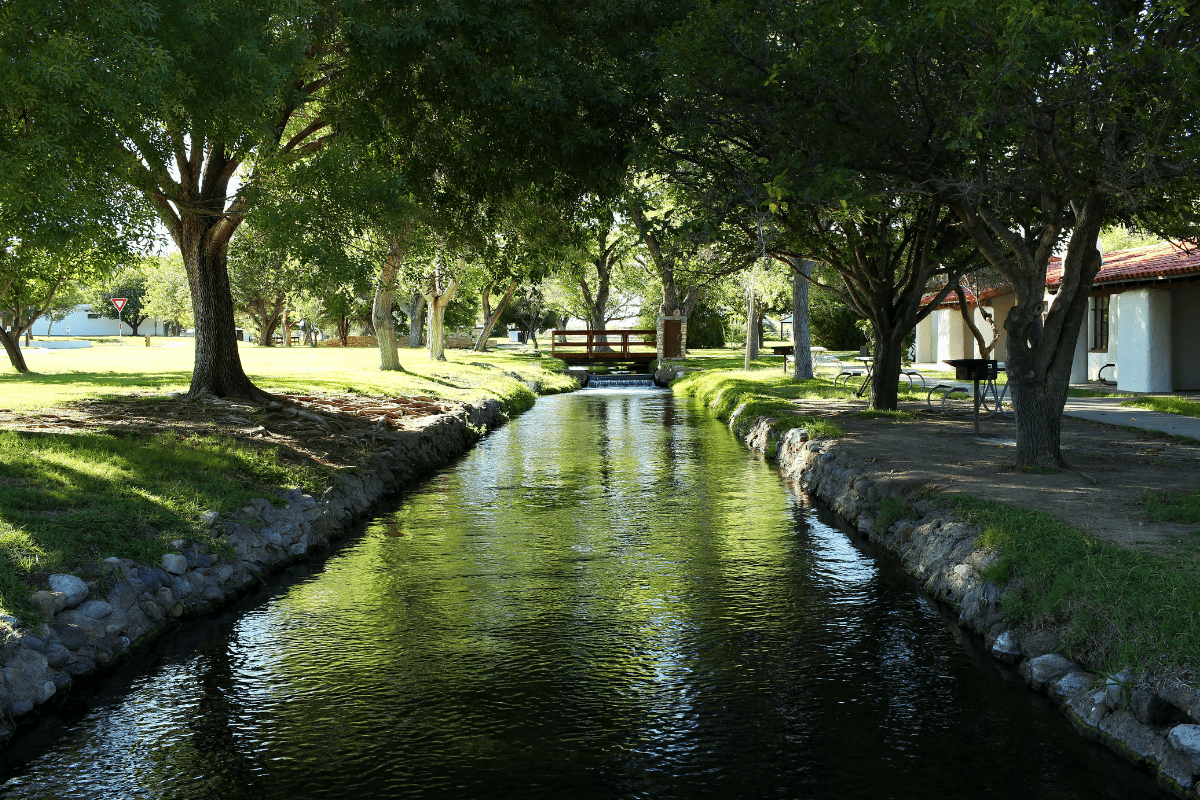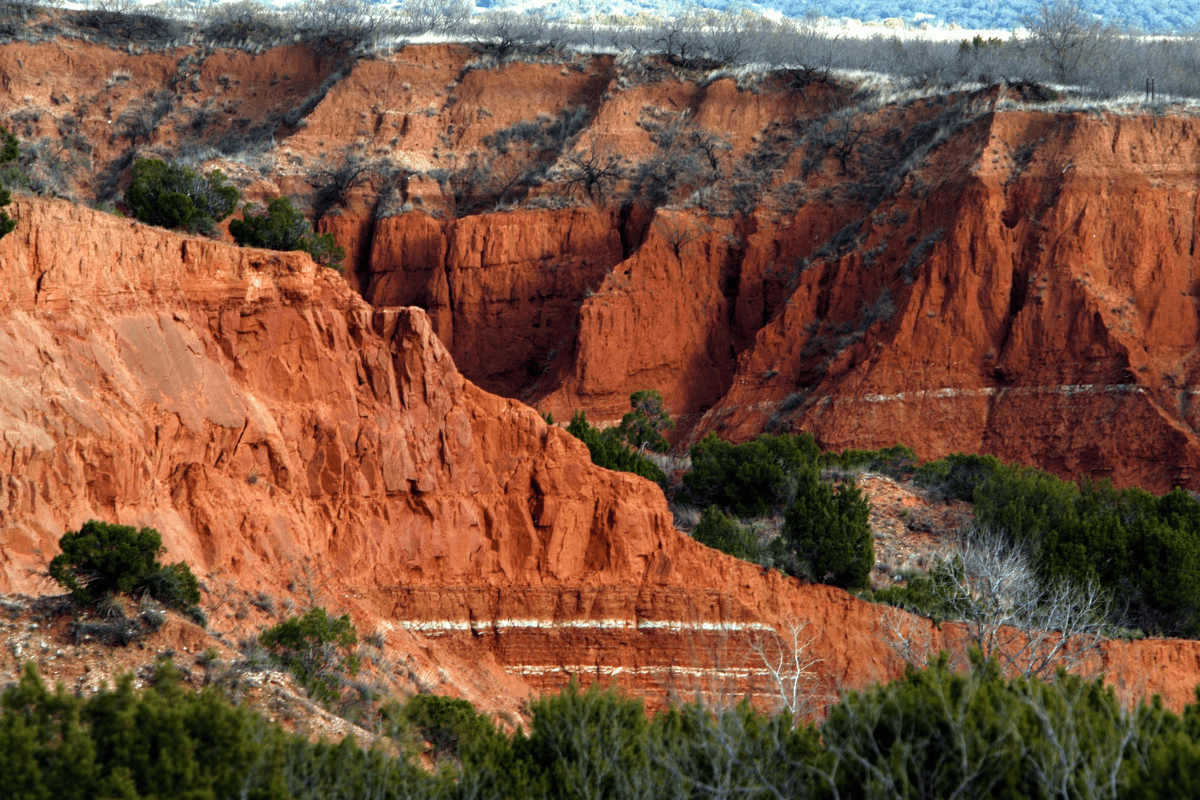Everyone knows about the Alamo and Big Bend, but Texas hides some seriously incredible destinations that most tourists completely miss. After digging deep into the state's lesser-known spots, I've uncovered seven places that'll give you authentic Texas experiences without fighting crowds for parking spots.
Monahans Sandhills State Park: Texas's unexpected desert playground
Picture this: you're driving through flat West Texas oil country when suddenly massive sand dunes appear out of nowhere, looking like someone transported the Sahara to the middle of the Permian Basin.
Getting your bearings in the sand
Located just six miles north of Interstate 20 on Park Road 41 in Monahans, this 3,840-acre park features sand dunes towering up to 70 feet high. The GPS coordinates (31°39'28"N, 102°49'52"W) will get you there, though honestly, it's pretty hard to miss once you see the giant wall of sand rising from the prairie.
What makes this place special isn't just the novelty of finding dunes in Texas. These formations developed over thousands of years as wind deposits created a semi-arid ecosystem that's completely different from anything else in the state. There aren't any designated trails here… you just wander wherever the sand takes you. Kids and adults alike rent sand discs for five bucks at headquarters and spend hours sledding down the steep slopes.
Planning your sand adventure
Here's what you need to know before you go:
- Entry fee: $4 per person (ages 13+)
- Park hours: 7 AM to 10 PM daily
- Reservation hotline: (432) 943-2092
- Nearest real town: Midland (30 miles away)
The park frequently hits capacity despite being in the middle of nowhere, so you'll definitely want to call ahead for reservations. Trust me on this one… driving all the way out there only to be turned away would seriously stink.
The sand reflects UV rays like crazy, turning you into a lobster faster than you'd think possible. Bring twice as much sunscreen as you think you need. On the flip side, the minimal light pollution makes this one of the best stargazing spots in Texas. Roadrunners and mule deer occasionally make appearances, though they're probably judging you for attempting to sandboard in cowboy boots.
Krause Springs: The Hill Country's best-kept swimming secret
About 30 miles west of Austin near Spicewood, there's a 115-acre property that's been in the same family for over 50 years, and they've managed to keep it wonderfully unspoiled.
Nature's perfect swimming hole
Krause Springs sits at 424 County Road 404 in Spicewood, featuring 32 natural springs that maintain a constant 68-degree temperature year-round. The springs flow through butterfly gardens decorated with massive wind chimes before tumbling down into Lake Travis. It's like someone designed the perfect Texas swimming hole and then actually built it.
The property, listed on the National Registry of Historical Sites, offers both natural spring-fed pools and a man-made pool, all shaded by cypress trees that are literally centuries old. There's a rope swing for the brave souls and a small waterfall that makes you feel like you've discovered some secret tropical paradise… except you're still in Texas.
Beating the crowds (yes, there's a strategy)
The gates open at 9 AM, and if you're not there within the first hour, good luck finding parking. Once the single parking lot fills up, they operate on a one-in, one-out basis, which can mean waiting in your car for hours during peak summer weekends.
Essential visitor information:
- Adults pay $10
- Kids cost $6
- Open March through October
- Camping available ($15 per adult)
- 24 RV sites with hookups
Whatever you do, bring water shoes. The rocks throughout the property are slicker than a politician's promises, and watching people slip and slide would be funny if it weren't so painful looking. They don't allow pets, which honestly helps keep the place pristine.
Balmorhea State Park: Swimming in a piece of history
Out in Far West Texas, the Civilian Conservation Corps built something remarkable in the 1930s that still draws people from hundreds of miles away.
The world's largest spring-fed swimming pool
Located at 9207 TX-17 in Toyahvale, Balmorhea State Park centers around San Solomon Springs, which pumps out 22 to 28 million gallons of crystal-clear water every single day. The CCC channeled this flow into a 1.3-acre pool that holds 3.5 million gallons and requires zero chlorination because the water constantly cycles through.
The water stays between 72 and 76 degrees year-round, creating perfect swimming conditions even in January. The pool reaches depths of 25 feet in some spots, which is why scuba divers love this place… where else can you practice diving in West Texas? You can actually see native fish and turtles swimming around with you, which freaks some people out but I think it's pretty cool.
Know before you dive in
The park limits capacity to 650 visitors per day, and they're strict about it. No amount of sweet-talking will get you in once they hit that number. Admission costs $7, with an extra $5 if you're scuba diving.
Key things to remember:
- No lifeguards on duty
- Snorkel gear available at park store
- Historic CCC motel rooms on-site
- Toyahvale has basically nothing… bring supplies
The San Solomon Springs Courts, those original CCC-built motel rooms, offer a unique way to stay right in the park. They're basic but clean, and there's something special about sleeping in the same buildings swimmers have used since the 1930s.
Mason County: Where Texas topaz meets authentic Hill Country charm
About two hours northwest of Austin, the town of Mason (population 2,100) holds a distinction no other place on Earth can claim.
The only spot on the planet for Texas topaz
Mason is literally the only place worldwide where you can find naturally occurring Texas topaz, the official state gemstone. Two ranches offer guided topaz hunting, though finding the gems requires patience and usually a lot of digging in the Texas heat.
The town itself escaped the tourist transformation that hit nearby Fredericksburg, maintaining its authentic frontier character. The courthouse square ranks among the five most beautiful in Texas, surrounded by buildings from 1910 that now house seven wine-tasting venues in the area's newly established AVA regions.
Beyond the gemstones
From May through September, you can watch 1.6 million Mexican free-tailed bats emerge from the Eckert James River Preserve at sunset. It's less famous than the Congress Avenue Bridge in Austin but honestly more impressive because you're out in nature instead of standing on concrete.
Mason highlights worth your time:
- Cooper's Original Pit BBQ (since 1953)
- Odeon Theater (continuous operation since 1928)
- Fort Mason self-guided tours
- Seaquist House monthly mansion tours
- German heritage from 1846 settlers
Downtown businesses typically open Thursday through Sunday, which actually works great if you're planning a long weekend trip. Call the Mason County Chamber at (325) 347-5758 for current information, especially about topaz hunting availability.
Daingerfield State Park: Texas actually does fall foliage
Most Texans will tell you we don't get real fall colors, but they've obviously never been to Daingerfield State Park in Northeast Texas.
The Cathedral of Trees lives up to its name
This 507-acre park at 455 Park Road 17 in Daingerfield earned its "Cathedral of Trees" nickname from towering pines that exceed 100 feet in height. These giants surround an 80-acre lake that the CCC enhanced back in 1938, creating facilities that blend perfectly with the forest setting.
The 2.4-mile Rustling Leaves Trail circles Little Pine Lake, offering perfect reflections on calm mornings that'll make your Instagram followers think you've traveled to New England. The no-motor policy on the lake keeps things peaceful, and you can rent kayaks or canoes if you didn't bring your own.
Timing your visit for maximum color
Peak fall foliage happens from mid-October through mid-November, and yes, the leaves actually turn brilliant reds, oranges, and yellows. The park charges just $4 admission for anyone 13 and older, with gates open from 6 AM to 10 PM daily.
The Bass Lodge and historic CCC-built cabins showcase the craftsmanship of the 1930s, and they're actually affordable to rent… if you book months in advance for fall season. Early morning visits reward you with mist rising through the trees and decent chances of spotting deer, armadillos, and various birds that call the forest home.
Christmas Bay: The paddler's paradise nobody knows about
Down near Freeport on the Texas coast, there's a bay that looks exactly like coastal Texas did before humans started building condos on every available inch of shoreline.
Crystal-clear waters and untouched ecosystems
Christmas Bay covers 4,173 acres and contains the highest diversity of finfish in the entire Galveston Bay system. The state designated it as both a Coastal Preserve and a nursery habitat, which basically means it's incredibly important ecologically and wonderfully unspoiled for visitors.
You can access the bay via Bluewater Highway (CR 257), with boat launches at Amigo Lane or San Luis County Park. The official paddling trails cover 19.1 miles, marked with 29 numbered GPS waypoints, though some markers got damaged in recent hurricanes.
Why kayakers love this place
The shallow waters, often just a few feet deep, create perfect conditions for wildlife viewing and wade fishing. You'll paddle over:
- Extensive oyster reefs
- Pristine cordgrass marshes
- Seagrass beds
- Crystal-clear tidal pools
Since most powerboats can't navigate the shallow waters, you'll have the bay mostly to yourself. Spotted seatrout, redfish, and flounder cruise the shallows, while the adjacent 42,000-acre Brazoria National Wildlife Refuge ensures the surrounding landscape stays wild.
Kayak rentals in nearby Freeport run about $50 per day, and several outfitters offer guided tours if you want local expertise. Best conditions occur during moving tides, with spring and fall offering the most comfortable weather. The access is completely free, which feels almost wrong considering how pristine this place remains.
The Salt Palace Museum: Where licking the walls is encouraged
In the small town of Grand Saline, about an hour east of Dallas, sits one of Texas's weirdest attractions that's actually worth the detour.
A building you can taste
The Salt Palace at 100 West Garland Street is the only building in North America made entirely from rock salt blocks. And yes, they actually encourage visitors to lick the walls… their reasoning being that salt kills germs, so it's totally sanitary. I'm not sure about the science there, but when in Rome, right?
The building sits atop a 250-million-year-old salt dome that descends 20,000 feet below the town. This massive deposit contains some of the purest salt on Earth, measuring 99.9% pure sodium chloride. The Caddo tribes started harvesting salt here around 800 AD, and today Morton Salt operates a mine that descends 57 stories underground.
More than just a salty oddity
The current building, constructed in 1993, is actually the fourth version dating back to the 1936 Texas Centennial. The museum opens Monday through Saturday from 9 AM to 4 PM, with free admission that includes a crystal of local salt to take home.
What makes this place special:
- Video presentations of mining operations
- Knowledgeable volunteer docents
- View of historic salt marshes
- Genuinely interesting geological history
You can see the actual salt marsh on FM 857 where natural salt springs first attracted indigenous peoples and later European settlers. The whole experience takes about an hour, making it a perfect stop if you're driving between Dallas and Shreveport.
Making the most of Texas's hidden treasures
These seven destinations showcase a Texas that most people never experience… one where you can sandboard in the morning and swim in spring-fed pools by afternoon, where frontier towns still feel authentic, and where nature remains wonderfully undisturbed.
The best times to visit most of these spots are spring (March through May) and fall (September through November), when Texas weather actually cooperates with outdoor activities. Many of these places limit visitor numbers to preserve their character, so advance reservations aren't just recommended… they're essential. Don't be that person standing at the gate with a carload of disappointed kids because you didn't call ahead.
Pack more supplies than you think you need, especially water and snacks. Some of these destinations are genuinely remote, and the nearest convenience store might be 30 miles away. But that's part of what makes them special. In a state where everything's supposedly bigger, sometimes the best experiences come in smaller, quieter packages that require a little extra effort to reach.
The drive to these hidden gems becomes part of the adventure, taking you through parts of Texas that interstate highways bypass. You'll see working ranches, tiny towns with more cows than people, and landscapes that change dramatically every hundred miles. That's the real Texas, and it's waiting for anyone willing to venture beyond the tourist trail.





